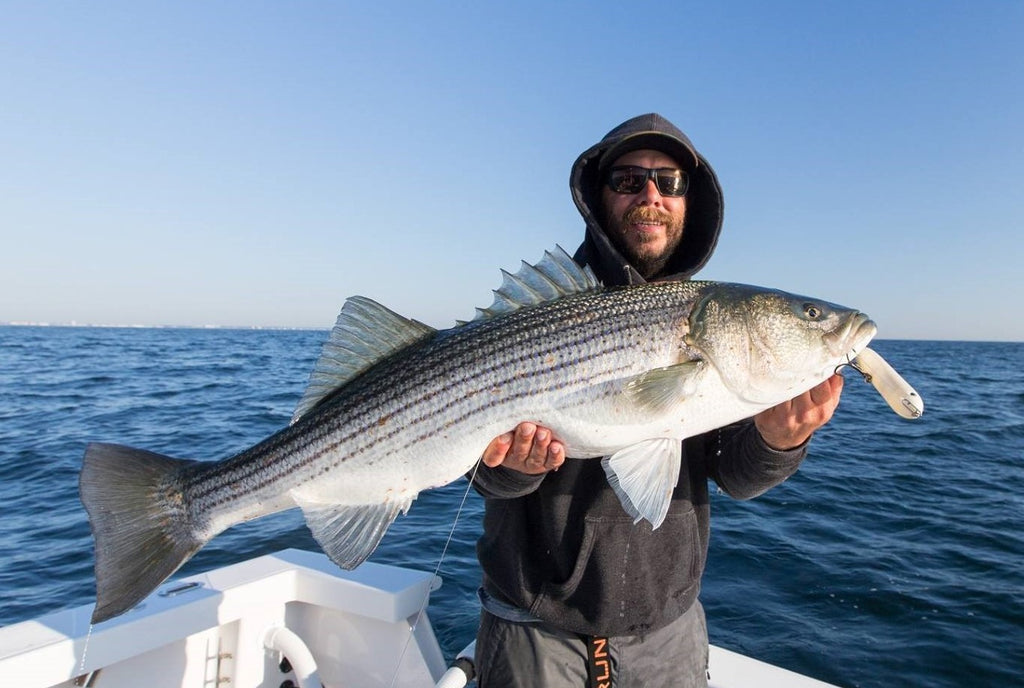A New Fishing Season Set to Kick Off Along the Northeast Coast
February 15, 2023

Captain Robbie Radlof shares striped bass and tuna calendars and strategies
PARK FALLS, WIS. (February 6, 2023) – Atlantic Striped bass live from the St. Lawrence River in Canada to the St. John’s River in Northern Florida. Surprised that Atlantic stripers range that far south? If so, you may be even more surprised to learn that there’s also a population of striped bass along the coast of the Gulf of Mexico between Florida and Louisiana. Historically, this Gulf population ranged all the way to Corpus Christi Bay in Texas. Today, in addition to being stocked in inland reservoirs throughout the country, there’s a Pacific population of stripers too. Striped bass from New Jersey were introduced into San Francisco Bay in the late 1800s. While their West Coast stronghold remains the bay and the Sacramento River, these adaptive fish now range in the Pacific from British Columbia all the way to Baja California.
Stripers are anadromous, meaning they spend most of their lives in salt water and migrate into freshwater rivers to spawn in the springtime. Juvenile striped bass typically remain close to their natal rivers in coastal estuaries for two to four years before migrating to the ocean. Some stripers, however, stay in those inshore bays and estuaries their entire lives. Male bass reach sexual maturity at two-to-four years of age, while females won’t spawn until they’re four to eight. Biologists say striped bass can live up to 30 years, allowing the biggest females to reach weights exceeding 70 pounds.
The roughly 350 miles of coastline between Cape May, New Jersey and Cape Cod, Massachusetts could be considered the goldilocks zone for Atlantic striped bass, where they’re stalked along the beaches and bays, as well as farther offshore where they’re often joined by Atlantic bluefin and yellowfin tuna. The lure of 50-pound bass and giant tuna make it a bucket-list fishery for any serious angler. But checking this box requires some help.
Captain Robbie Radlof, 41, grew up fishing Raritan Bay and its tributaries for striped bass with his father and grandfather. The St. Croix Rod pro staffer and product-development team member bought his first center console in 1999 and earned his U.S. Coast Guard license in 2004. Through decades of exploration and observation, Radlof has become one of the best in the game at consistently hunting down large bluefin and yellowfin tuna, as well as making a living putting his clients on striped bass from March through December. He runs his 27’ Conch for Waterman Charters out of Sherer’s Boat Basin in Barnegat, New Jersey, chasing bass from Raritan Bay to Delaware Bay, and tuna as far as 115 miles offshore.

While Radlof’s boat is still on the hard, he’s busy preparing for the upcoming fishing season, which begins in just a few weeks. “You can find bass year around, but my striper fishing usually begins with our first significant warm-up in March,” Radlof says. “That initial warmth brings the first push of fish into Raritan Bay and into the Hudson River to spawn. That’ll continue through mid-April or so, and we can continue to enjoy good, concentrated fishing for large, mature bass in shallow water through May as post-spawn fish trickle back out into the bay and hold on structure in predictable spots.”
These springtime bass show up in the Hudson River estuary hungry and ready to spawn, filtering in from offshore waters and from the south. Radlof says they stack up in all the familiar locations – holding in the larger bays, pushing into the creeks, and patrolling the channel edges in open water. Similar striper action builds from March through May at the south end of New Jersey in the Cape May area.
“Pre- and post-spawn, we’re usually only fishing in two to ten feet of water,” Radlof says. “They’re mainly feeding on adult bunker, so we’re using a lot of big topwater lures and swimming plugs like 2-ounce Bombers to match the forage.” Radlof says the 9” Doc and 7” Li’l Doc by Musky Mania Tackle are two of his favorite topwater lures. He’ll spool with 30-50-pound braid and fish any of these artificials on either a St. Croix RIFT Salt 73MMF, 73MHMF or a Mojo Inshore 79XHMF conventional rod, depending on the lure and the size of the fish. Only a decade ago, most anglers expected to catch their biggest bass of the year during the fall migration, but recent years have seen some of the biggest cows trailing these bunker schools post-spawn in May and June.

Radlof says the structure fishing continues throughout the summer from July through September, although in a little deeper water with heavier current. He’s usually fishing bucktail jigs and swimming shads in less than 40 feet of water with his favorite Mojo Inshore 79XHMF conventional rod or one of the new Legend Tournament Inshore 79XHMF spinning rods. Of course, the topwater fanatic he is, Radlof is always ready to present a Doc or other surface lure to any fish that gives itself away.
Come October, Radlof says big stripers push back shallow to gorge on all the bait coming out of the rivers and creeks. “We haven’t gotten sand eels inshore for the past two falls,” Radlof says. “We had them every fall for years, but bunker – both adult and peanut – have taken over the fall striper run. It’s a crazy fun time… pretty much all blitz fishing on the surface with Tsunami Talking Poppers and similar stuff. All you have to do is chase the birds and you’ll find the fish.” Radlof employs the same RIFT Salt and Mojo Inshore rods he uses during the spring run and says the blitzes typically last through Thanksgiving. “You can always find fish in December, but most are pushing offshore or headed south by then.”

While he has to run a bit farther to find them – sometimes 60 to 115 miles offshore – Radlof says the tuna fishing fires up off the Jersey coast in June, sometimes as early as mid-May. “It usually starts with us pitching paddletails or chugging poppers to 40-to-60-pound-class schoolie bluefins. It’s a long day, but certainly worth the effort for clients who are up for it,” Radlof says. “We may leave at 1:00 or 2:00 in the morning and be ready to fish at first light. We’ll fish until early afternoon then make the run back home.”
Radlof says the yellowfins show up next. “The bluefins usually stick around and we can find them into December, but his past year we had the bluefins in the summer and they all went north to Cape Cod, but a bunch of 35-65-pound yellowfins moved in right behind them.” Regardless of the species, Radlof says the fishing usually starts on the surface. “We’re using 7’10” medium-heavy power, moderate-fast action RIFT Salt spinning rods (RIFSS710MHMF) with 8000 size spinning reels and 50-65-pound braided line to cast lures like 5.5” three-ounce Hogy Protail Paddles or three-ounce Nomad Chug Norris Poppers.

“Once the tuna get on butterfish and sand eels, we start fishing jigs. Since they’re not blitzing on the surface, I’ll use my electronics to find bait and tuna on the edges of the canyons in 180 to 220 feet of water, then we just drop down to them,” Radlof says. This is where gear gets a bit more specialized.

“15 to 20 years ago, all our tuna were 40 or 50 pounds, but now we’ve got a lot of fish over 100. The problem is that jigging rods were too slow. If you found one that could work one of the smaller 80-to-160-gram jigs these fish want to eat, they didn’t have the power to fight the fish quickly enough that it could be safely released,” Radlof explains. “The way we designed these new St. Croix RIFT Jig rods, the tips are dialed in so they’re able to work a variety of the lighter jigs we need to catch fish, while the butts and mid sections are beefed up so there’s plenty of power to land these tuna and release them quickly. Most rods are too fast to work a really light jig in these situations. These RIFT Jig rods are very versatile and allow anglers to fish those key 80–160-gram jigs with the power to catch fish up to 200 pounds.”

Radlof’s fishing expertise is only overshadowed by his humility. After the development and testing was through, he knew how special RIFT Jig rods were. He also had the foresight to know how these rods were going to help anglers solve problems and catch more fish all around the world – not just the tuna fishery out his backdoor. He came up with the idea of labeling these rods based on the size of the fish they’re designed to catch. “There are six spinning models and six conventional models in the current RIFT Jig lineup,” Radlof says. “Each one of these rods is individually labeled for fish weighing up to 35 pounds, 50 pounds, 100 pounds, 150 pounds, or 200 pounds. So, regardless of what species an angler is fishing for and where they are fishing – whether they want a spinning model or a conventional model – they can make a confident decision on which RIFT Jig rod is going to be best for them by only knowing the upper range of the weights of the fish they expect to catch. That’s a huge advantage. St. Croix talks all the time about how they are an angler-driven company. They prove it time and time again by listening to and implementing the ideas of their professional fishing staff.”
Radlof most often uses the RIFT Jig 5’8” heavy power spinning model (RIFJS58H) or the 5’8” extra-heavy power spinning model (RIFJ58XH). “I’ll use the 5’8” heavy for fish between 50 and 100 pounds, then move up to the 5’8” extra-heavy for fish between 100 and 150,” he says. “In addition to their unique tapers, RIFT rods – the whole series, really – are incredible boat rods. Given their extreme durability, they are surprisingly light and thin with great ergonomics that make it easier for my clients to enjoy this demanding style of fishing.”
Radlof says and yellowfin usually stick around through October, and bluefin are accessible – in a normal year – into December. Then, it’s time to haul out and start planning for the next season of striper and tuna fishing along the Jersey coast.
Follow Captain Robbie’s angling adventures on Instagram. For more information on charters or to book a trip, visit watermancharters.com.

